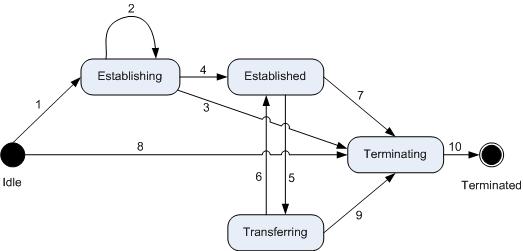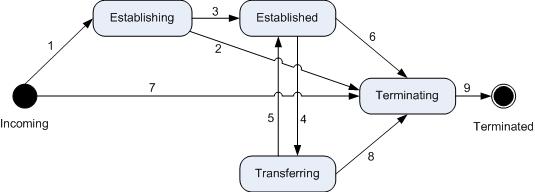An InstantMessagingCallobject represents an SDP-based instant message (IM) session between a local participant and a remote participant. An InstantMessagingCallobject cannot exist on its own; it must be associated with a Conversationobject.
Because an IM call can be forked by Microsoft Office Communications Server, the receiving end should have logic to determine which endpoint should accept the IM call. Normally, this process is done by the most active endpoint as determined by the device state published by all of the endpoints. If there is only one endpoint, the IM can be autoaccepted immediately. Otherwise, the user should be given the opportunity to click the toast message so that the IM can be accepted on that endpoint. If the user does not click any of the toast messages within 10 seconds, the most active endpoint should accept the IM. This allows the message to flow so that the user can see the missed message when returning to the device.
When an IM call is established, it is customary to include a “toast” message, which is generally a text/plain message.
 InstantMessagingCall State
Transitions – Outbound Calls
InstantMessagingCall State
Transitions – Outbound Calls
The InstantMessagingCallstate transitions for an outbound call are shown in the following illustration.

- The transition from
Idleto
Establishingoccurs when the application calls
BeginEstablishon the call.
- The transition from
Establishingto
Establishingoccurs when the application receives the first
ringing notification from the remote side while the call is in the
Establishingstate.
- The transition from
Establishingto
Terminatingoccurs when
BeginEstablishfails, or when the application calls
BeginTerminateon the call, or when the application calls
BeginTerminateon the conversation that contains this call.
- The transition from
Establishingto
Establishedoccurs when
EndEstablishcompletes successfully.
- The transition from
Establishedto
Transferringoccurs when the application calls
BeginTransferon the call.
- The transition from
Transferringto
Establishedoccurs when
BeginTransferis unsuccessful.
- The transition from
Establishedto
Terminatingoccurs when the application calls
BeginTerminateon the call, or when the remote side
terminates the call, or when the application calls
BeginTerminateon the conversation that contains this call.
- The transition from
Idleto
Terminatingoccurs when the application calls
BeginTerminateon the call, or when the application calls
BeginTerminateon the conversation that contains this call.
- The transition from
Transferringto
Terminatingoccurs when the application calls
BeginTerminateon the call, or when the transfer operation is
successful, or when the application calls
BeginTerminateon the conversation that contains this call.
- The transition from
Terminatingto
Terminatedoccurs when
EndTerminatecompletes.
 InstantMessagingCall State
Transitions – Inbound Calls
InstantMessagingCall State
Transitions – Inbound Calls
The InstantMessagingCallstate transitions for an inbound call are shown in the following illustration.

- The transition from
Incomingto
Establishingoccurs when the application calls
BeginEstablishon the call.
- The transition from
Establishingto
Terminatingoccurs when the call is not accepted, or when the
application calls
BeginTerminate, or when the application calls
BeginTerminateon the conversation that contains this call.
- The transition from
Establishingto
Establishedoccurs when the call is accepted (when
BeginAcceptreturns successfully).
- The transition from
Establishedto
Transferringoccurs when the application calls
BeginTransferon the call.
- The transition from
Transferringto
Establishedoccurs when
BeginTransferis unsuccessful.
- The transition from
Establishedto
Terminatingoccurs when the application calls
BeginTerminateon the call, or when the remote side
terminates the call, or when the application calls
BeginTerminateon the conversation that contains this call.
- The transition from
Incomingto
Terminatingoccurs when the application calls
Decline,
Forward, or
BeginTerminateon the call, or when the application calls
BeginTerminateon the conversation that contains this call,
or when the remote side cancels its call request.
- The transition from
Transferringto
Terminatingoccurs when the application calls
BeginTerminate, or when the transfer operation completes
successfully, or when the application calls
BeginTerminateon the conversation that contains this call.
- The transition from
Terminatingto
Terminatedoccurs when
EndTerminatecompletes.
 InstantMessagingCall
Constructors
InstantMessagingCall
Constructors
The InstantMessagingCallclass has the following constructor.
 Copy Code Copy Code
|
|
|---|---|
// Initializes the call based on the conversation and the signaling session. public InstantMessagingCall(Conversation conversation); |
|
 InstantMessagingCall
Properties
InstantMessagingCall
Properties
The following are the public properties on the InstantMessagingCallclass.
 Copy Code Copy Code
|
|
|---|---|
// Gets whether this call should be accepted immediately upon
receipt.
public bool IsImmediateAutoAcceptNeeded {get;}
// Gets the default media type for this call. For
InstantMessagingCall, default mediaType is Message.
public override string DefaultMediaType {get;}
/ Gets the list of supported Media names,
// which are acceptable m-lines in and SDP offer/answer.
// For InstantMessagingCall, Message is the only supported
MediaType.
public override IEnumerable<string> SupportedMediaTypes
{get;}
// Gets the InstantMessagingFlow instance for this call.
public InstantMessagingFlow Flow {get;}
|
|
 InstantMessagingCall
Methods
InstantMessagingCall
Methods
The following are the public methods on the InstantMessagingCallclass.
 Copy Code Copy Code
|
|
|---|---|
// Establishes an instant messaging call to the remote participant public IAsyncResult BeginEstablish( string destinationUri, ToastMessage toastMessage, CallEstablishOptions options, AsyncCallback userCallback, object state); // Asynchronously establishes the session. public IAsyncResult BeginEstablish( ToastMessage toastMessage, CallEstablishOptions options, AsyncCallback userCallback, object state) |
|
 InstantMessagingCall
Events
InstantMessagingCall
Events
The following are the public events on the InstantMessagingCallclass.
 Copy Code Copy Code
|
|
|---|---|
// Raised when the call must be autoaccepted by the application. // The implementation of the handler for this event should use a lock object // to eliminate a possible race condition between this event being // raised on the application's event thread and the application calling // BeginAccept(), Decline(), and other methods on the application's main thread // or on any other thread. public event EventHandler<EventArgs> AutoAcceptNeeded; // Raised when the instant messaging flow is created. public event EventHandler<InstantMessagingFlowCreatedEventArgs> InstantMessagingFlowConfigurationRequested; |
|
 Important:
Important: |
|---|
| An event handler for the InstantMessagingFlowConfigurationRequestedevent is called synchronously. A deadlock in application code can prevent the application from terminating the call or shutting down the platform. |





